Glimepiride reduces CD14 expression and cytokine secretion from macrophages
- PMID: 24952384
- PMCID: PMC4080699
- DOI: 10.1186/1742-2094-11-115
Glimepiride reduces CD14 expression and cytokine secretion from macrophages
Abstract
Background: Activated microglia are associated with deposits of aggregated proteins within the brains of patients with Alzheimer's disease (AD), Parkinson's disease (PD) and prion diseases. Since the cytokines secreted from activated microglia are thought to contribute to the pathogenesis of these neurodegenerative diseases, compounds that suppress cytokine production have been identified as potential therapeutic targets. CD14 is a glycosylphosphatidylinositol (GPI)- anchored protein that is part of a receptor complex that mediates microglial responses to peptides that accumulate in prion disease (PrP82-146), AD (amyloid-β (Aβ)42) and PD (α-synuclein (αSN)). As some GPI-anchored proteins are released from cells by treatment with glimepiride, a sulphonylurea used for the treatment of diabetes, the effects of glimepiride upon CD14 expression and cytokine production from cultured macrophages were studied.
Methods: RAW 264 cells and microglial cells were treated with glimepiride or phosphatidylinositol (PI)-phospholipase C (PLC) and the expression of cell receptors was analysed by ELISA and immunoblot. Treated cells were subsequently incubated with Aβ42, αSN, PrP82-146 or lipopolysaccharide (LPS) and the amounts of Toll-like receptor (TLR)-4, tumour necrosis factor (TNF), interleukin (IL)-1 and IL-6 measured.
Results: Glimepiride released CD14 from RAW 264 cells and microglial cells. Pre-treatment with glimepiride significantly reduced TNF, IL-1 and IL-6 secretion from RAW 264 and microglial cells incubated with LPS, Aβ42, αSN and PrP82-146. Glimepiride also reduced the LPS, Aβ42, αSN and PrP82-146-induced translocation of TLR-4 into membrane rafts that is associated with cell activation. These effects of glimepiride were also seen after digestion of RAW 264 cells with PI-phospholipase C (PLC). In addition, the effects of glimepiride were blocked by pharmacological inhibition of GPI-PLC. The cytokine production was CD14-dependent; it was reduced in microglia from CD14 knockout mice and was blocked by antiserum to CD14.
Conclusions: RAW 264 and microglial cell responses to Aβ1-42, αSN, PrP82-146 and LPS are dependent upon CD14 expression. Glimepiride induced the shedding of CD14 from cells by activation of GPI-PLC and consequently reduced cytokine production in response to Aβ42, αSN, PrP82-146 and LPS. These results suggest that glimepiride acts as a novel anti-inflammatory agent that could modify the progression of neurodegenerative diseases.
Figures
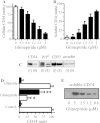
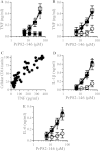

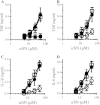
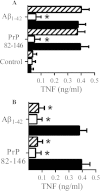
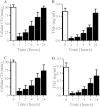
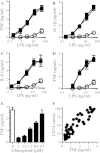

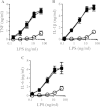
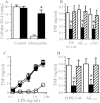
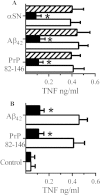


Similar articles
-
Glimepiride protects neurons against amyloid-β-induced synapse damage.Neuropharmacology. 2016 Feb;101:225-36. doi: 10.1016/j.neuropharm.2015.09.030. Epub 2015 Oct 8. Neuropharmacology. 2016. PMID: 26432105
-
Microglial p38α MAPK is a key regulator of proinflammatory cytokine up-regulation induced by toll-like receptor (TLR) ligands or beta-amyloid (Aβ).J Neuroinflammation. 2011 Jul 6;8:79. doi: 10.1186/1742-2094-8-79. J Neuroinflammation. 2011. PMID: 21733175 Free PMC article.
-
P2X7 receptor modulation of beta-amyloid- and LPS-induced cytokine secretion from human macrophages and microglia.J Neuroimmunol. 2004 Feb;147(1-2):56-61. doi: 10.1016/j.jneuroim.2003.10.014. J Neuroimmunol. 2004. PMID: 14741428
-
GM-CSF increases LPS-induced production of proinflammatory mediators via upregulation of TLR4 and CD14 in murine microglia.J Neuroinflammation. 2012 Dec 13;9:268. doi: 10.1186/1742-2094-9-268. J Neuroinflammation. 2012. PMID: 23234315 Free PMC article.
-
Glimepiride reduces the expression of PrPc, prevents PrPSc formation and protects against prion mediated neurotoxicity in cell lines.PLoS One. 2009 Dec 9;4(12):e8221. doi: 10.1371/journal.pone.0008221. PLoS One. 2009. PMID: 20011040 Free PMC article.
Cited by
-
The Anti-diabetic Drug Gliquidone Modulates Lipopolysaccharide-Mediated Microglial Neuroinflammatory Responses by Inhibiting the NLRP3 Inflammasome.Front Aging Neurosci. 2021 Oct 29;13:754123. doi: 10.3389/fnagi.2021.754123. eCollection 2021. Front Aging Neurosci. 2021. PMID: 34776934 Free PMC article.
-
Computational identification of potential multi-drug combinations for reduction of microglial inflammation in Alzheimer disease.Front Pharmacol. 2015 Jun 5;6:116. doi: 10.3389/fphar.2015.00116. eCollection 2015. Front Pharmacol. 2015. PMID: 26097457 Free PMC article.
-
Neuroinflammation in Prion Disease.Int J Mol Sci. 2021 Feb 23;22(4):2196. doi: 10.3390/ijms22042196. Int J Mol Sci. 2021. PMID: 33672129 Free PMC article. Review.
-
Prion therapeutics: Lessons from the past.Prion. 2022 Dec;16(1):265-294. doi: 10.1080/19336896.2022.2153551. Prion. 2022. PMID: 36515657 Free PMC article. Review.
-
Cerebrospinal fluid levels of IL-6 are decreased and correlate with cognitive status in DLB patients.Alzheimers Res Ther. 2015 Oct 5;7(1):63. doi: 10.1186/s13195-015-0145-y. Alzheimers Res Ther. 2015. PMID: 26434635 Free PMC article.
References
-
- Schlachetzki JC, Hull M. Microglial activation in Alzheimer’s disease. Curr Alzheimer Res. 2009;6(6):554–563. - PubMed
-
- Zhang W, Wang T, Pei Z, Miller DS, Wu X, Block ML, Wilson B, Zhang W, Zhou Y, Hong J-S, Zhang J. Aggregated α-synuclein activates microglia: a process leading to disease progression in Parkinson’s disease. FASEB J. 2005;19(6):533–542. - PubMed
-
- Klegeris A, Walker DG, McGeer PL. Interaction of Alzheimer beta-amyloid peptide with the human monocytic cell line THP-1 results in a protein kinase C-dependent secretion of tumor necrosis factor-alpha. Brain Res. 1997;747(1):114–121. - PubMed
Publication types
MeSH terms
Substances
LinkOut - more resources
Full Text Sources
Other Literature Sources
Research Materials
Miscellaneous

